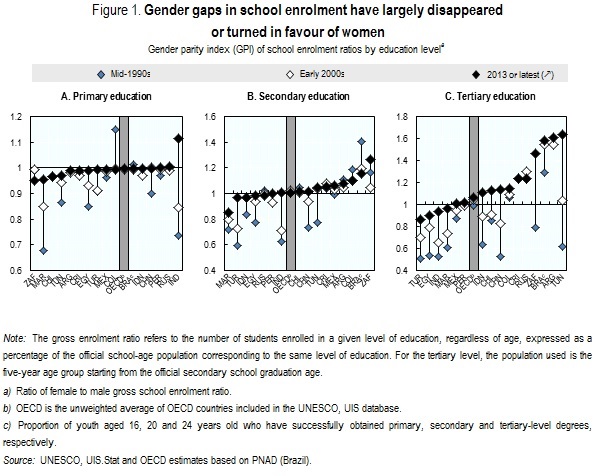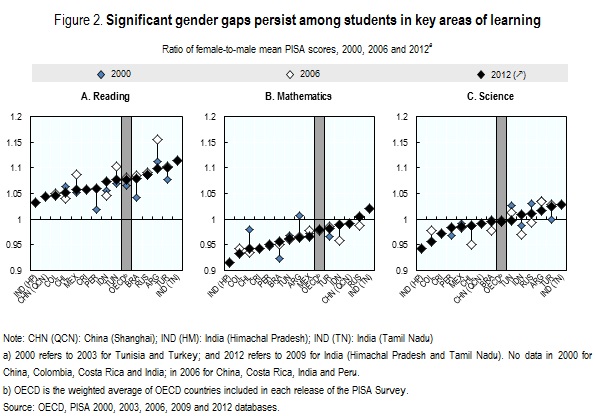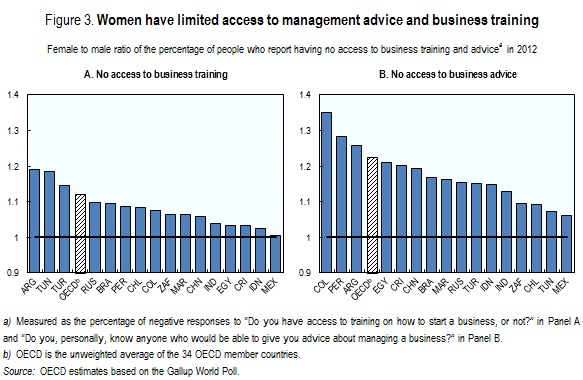By Paolo Falco.
Despite unprecedented progress over the past century, gender gaps in the labour market persist throughout the emerging world and are accompanied by important skill gaps. Most notably, women tend to perform worse in STEM subjects, have lower financial literacy and business knowledge than men. The OECD Employment Outlook 2016 paints an up-to-date picture of gender gaps in 16 emerging economies accounting for over half of the world’s population and outlines a comprehensive set of policy recommendations.
The integration of women into the labour market was one of the most momentous trends of the 20th century, and it was accompanied by an unprecedented process of skills catch-up. In 1950, women worldwide only had three quarters of the years of schooling that men had. By 2010, the ratio had almost reached 90% and it continues to increase (Barro and Lee, 2013). The rate of convergence was even higher in developing countries, where the same figure went from only 57% in 1950 to 86% in 2010. Today, enrolment rates in primary and secondary education are almost identical between boys and girls, and in many countries women have overtaken men in their propensity to attend tertiary education (Figure 1). Progress, however, has been markedly different across socio-demographic groups.[1]

While gaps in school enrolment have largely disappeared, gender differences in school results persist in most countries. Evidence from PISA demonstrates that girls typically outperform boys in reading, while they lag behind in mathematics, with the largest gaps registered in parts of India (Himachal Pradesh), Colombia and Chile (Figure 2). In science, the picture is more varied. These gaps, which have been quite stable since 2000, partly explain why in many countries girls are less likely than boys to pursue further studies in science, technology, engineering and mathematics (STEM) subjects (OECD, 2012, 2015), and later to work in STEM-related sectors.

Skill gaps also persist in financial literacy and business knowledge, with negative repercussions on female entrepreneurship. Recent OECD work shows that girls generally perform worse than boys in the PISA assessment of financial literacy (carried out throughout the OECD and in a number of emerging economies)[2] and are less confident in their financial knowledge. In addition, Gallup data highlight that women are less likely than men to have access to management advice and business training (Figure 3).

How to tackle skill gaps in emerging economies
In light of this evidence, policy makers should move beyond a narrow focus on boosting female school enrolment and concentrate as well on the contents and quality of teaching. Special efforts should be made to get girls more interested in mathematics and science, and boys more interested in reading. Gender bias in curricula should be removed (e.g. by phasing out gender stereotypes from textbooks, promoting female role models, and using learning materials that appeal to girls). Awareness should be raised on the likely consequences of choosing different fields of study for careers and earnings (OECD, 2012). Teachers should be adequately selected, trained and incentivised to attain greater gender parity in students’ choice of subjects and learning outcomes.
To tackle gender gaps in financial literacy, a number of countries have developed specific training programmes and some emerging economies, like Brazil and Turkey, have made women a specific target group of their national strategies for financial education. In Colombia, Brazil, Mexico and Peru financial education is one component of some conditional cash transfer schemes. Existing programmes typically cover financial product awareness, day-to-day financial management, borrowing, long-term financial planning and consumers’ rights. Many of them are targeted at disadvantaged socio-demographic groups and micro-entrepreneurs.[4] A growing body of impact evaluations shows they can be successful in raising women’s financial literacy and inclusion (see OECD, 2013 for a comprehensive review). However, evidence from the OECD International Network on Financial Education (INFE) stock-tacking exercise shows that policy awareness about the need to address gender differences in financial literacy remains low in many countries.
Finally, apprenticeships can also be used as a tool to close gender gaps. Work-based learning (WBL) and apprenticeship schemes can facilitate the transition from school to work and encourage labour market participation among young women at high risk of becoming inactive. Moreover, apprenticeships can be an effective measure to encourage women who have completed their STEM studies to work in scientific fields.[1] The design of effective apprenticeship systems requires concerted action between the public and the private sector. Employers should work closely with schools (particularly, but not exclusively, with technical and vocational education and training institutions) to ensure that curricula reflect the needs of the labour market, and to design apprenticeship schemes that are well-suited to the students’ competences.
Some good news
Policy efforts aimed at reducing skill gaps and gender segregation by field of study in emerging economies are starting to pay off (OECD, 2014). Mexico, for instance, is now one of the OECD countries that award the largest share of degrees in the field of computing to women (about 40% compared to an OECD average of 20%). It is followed closely by South Africa (37%). Argentina and Colombia are the emerging economies where the largest share of degrees in the field of engineering, manufacturing and construction is awarded to female students (over 35%, compared to an OECD average of 27.5%). Women in Argentina are also awarded 70% of all degrees in mathematics and statistics, compared to an OECD average of 46%. In most of the emerging world, however, severe gender gaps persist and improving women’s educational attainment should remain a primary concern for policy makers.
Footnotes
[1] Girls from poorer families are much less likely to be enrolled in school at all levels of education. For instance, among Indian children in the bottom fifth of the income distribution, an education gap of almost five years persists between boys and girls aged 15-19. By contrast, boys and girls from the top quintile participate in school at similar rates (World Bank, 2012). Minority groups are another stark example of persistent gender disadvantages. It is estimated that almost two-thirds of out-of-school girls globally belong to ethnic minority groups in their own countries (Lewis and Lockheed, 2006).
[2] Out of the emerging economies where the assessment was carried out, China (Shanghai) and the Russian Federation show a similar gender gap, while the gap is in favour of girls in Colombia (OECD PISA Database, 2012). A similar test carried out in South Africa and Peru also showed girls having lower financial literacy than boys (Atkinson and Messy, 2012; OECD, 2012).
[3] The project “Femmes Entrepreneuses en Méditerranée” (FEM) implemented in Tunisia and Egypt, for instance, was designed for small business owners and included a strong training component. In India, the Self-Employed Women’s Association (SEWA) organises financial literacy training for female entrepreneurs.
[4] Evidence from OECD countries shows that even when women pursue STEM studies, they are less likely than men to subsequently work in physics, mathematics and engineering (OECD, 2012).
References
Atkinson, A. and F.A. Messy (2012), “Measuring Financial Literacy: Results of the OECD/International Network on Financial Education (INFE) Pilot Study”, OECD Working Paper on Finance, Insurance and Private Pensions, No. 15, OECD Publishing, Paris, http://dx.doi.org/10.1787/5k9csfs90fr4-en.
Barro, R.J. and J.W. Lee (2013), “A New Data Set of Educational Attainment in the World, 1950-2010”, Journal of Development Economics, Elsevier, Vol. 104(C), pp. 184-198.
Lewis, M.A. and M.E. Lockheed (2006), Inexcusable Absence: Why 60 Million Girls Aren’t in School and What to Do About It, Center for Global Development, Washington, DC.
OECD (2016), OECD Employment Outlook 2016, OECD Publishing, Paris. DOI: http://dx.doi.org/10.1787/empl_outlook-2016-en.
OECD (2015), The ABC of Gender Equality in Education: Aptitude, Behaviour, Confidence, PISA, OECD Publishing, Paris, http://dx.doi.org/10.1787/9789264229945-en.
OECD (2014), Education at a Glance 2014: OECD Indicators, OECD Publishing, Paris, http://dx.doi.org/ 10.1787/eag-2014-en.
OECD (2013), Women and Financial Education: Evidence, Policy Responses and Guidance, OECD Publishing, Paris, http://dx.doi.org/10.1787/9789264202733-en.
OECD (2012), Closing the Gender Gap: Act Now, OECD Publishing, Paris, http://dx.doi.org/10.1787/9789264179370-en.
World Bank (2012), World Development Report 2012: Gender Equality and Development, World Bank, Washington, DC, https://openknowledge.worldbank.org/handle/10986/4391, License: CC BY 3.0 IGO.
Database References
OECD, PISA 2000, 2003, 2006, 2009 and 2012 Databases, http://www.oecd.org/pisa/pisaproducts.
